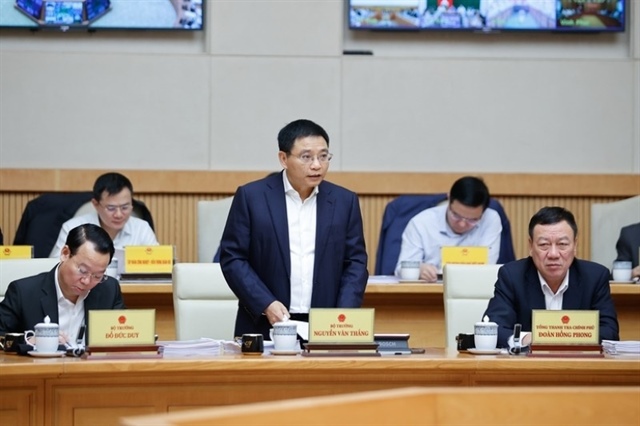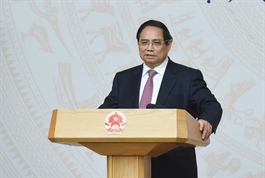MoF updates economic growth outlook for 2025 amid challenges
MoF updates economic growth outlook for 2025 amid challenges
After unveiling growth of 6.93 per cent in the first quarter of the year, the Ministry of Finance (MoF) has updated its outlook for 2025 amid fresh challenges.
At a regular government meeting and online conference between the government and localities on April 6 in Hanoi, Minister of Finance Nguyen Van Thang highlighted the positive results posted in Q1.

Minister of Finance Nguyen Van Thang giving remarks at a regular government meeting on April 6. Photo: VGP |
Specifically, Q1’s GDP growth has been estimated at 6.93 per cent, the highest rate for Q1 from 2020-2025.
This figure exceeded the initial target for Q1, set between 6.2-6.6 per cent, under the 6.5-7 per cent annual growth scenario for 2025, as regulated in governmental Resolution No. 01/NQ-CP dated January 8.
It was, however, still below the 7.7 per cent growth target for Q1 in the 8 per cent annual growth scenario for 2025.
Minister Thang noted that as growth drivers are at risk of weakening, achieving the 2025 growth target would pose a significant challenge.
If Vietnam faces a 46 per cent reciprocal tariff announced by the US administration on April 3, exports to the US would be strongly impacted, affecting industrial production, businesses, foreign direct investment, private investment, domestic consumption, and employment.
Furthermore, maintaining macroeconomic stability is at risk, and the living standards of certain segments of the population, especially manual workers, are expected to face greater challenges as production, business, and exports may be significantly impacted.
“This casts huge pressure on socioeconomic development management to achieve the growth targets. It requires proactive, decisive, focused, and further innovative actions from all levels, sectors, and localities,” Thang said.
Based on Q1 results, the MoF has updated its economic growth scenario for 2025.
Accordingly, to achieve the annual growth target of 8 per cent and beyond, the economy needs to grow by approximately 8.3 per cent in the last nine months of the year.
Growth for Q2 has been projected at 8.2 per cent, and in Q3 and Q4 the expected growth rates are 8.3 per cent and 8.4 per cent, respectively, about 0.2 percentage points higher than the initial scenario.
On January 8, the government outlined three growth scenarios for 2025. In the 8 per cent growth scenario, GDP growth for Q1 was expected to be 7.7 per cent. The corresponding growth rates were 8 per cent for Q2, 8.1 per cent for Q3, and 8.3 per cent for Q4.
To achieve the updated scenario, the MoF calculated that for Q2 alone, the processing and manufacturing sector needs to grow by 10.1 per cent on-year to continue being a key driver.
In addition, electricity and gas production should expand by 11.5 per cent, and the mining sector needs to further recover to contribute more to growth.
Moreover, public investment disbursement must be accelerated. There is still substantial room for public investment to drive growth, with a total public investment budget approximating $33.04 billion assigned by the National Assembly for 2025.
The service and tourism sectors had managed positive growth in Q1 and still hold significant potential for further expansion.
According to the MoF's report, the service sector grew by 7.7 per cent in Q1, contributing 53.74 per cent to overall growth.
Regarding tourism, Vietnam welcomed over six million international visitors in the first three months of the year, setting a record and a 29.6 per cent jump on-year.
To boost growth, the MoF has outlined 10 short-term tasks and solutions, along with six long-term tasks and solutions.
In the short term, the MoF emphasises strengthening dialogue and promoting bilateral negotiations with the US to reach a reasonable and appropriate countervailing tariff level to ensure a balanced outcome.
Additionally, it is important to maintain macroeconomic stability, strengthen the foundation for growth, boost public and domestic investment, attract foreign investment, develop and protect the domestic market, and promote tourism.
Furthermore, institutional and legal reforms should continue to improve the investment and business environment.
- 16:30 09/04/2025
























